[Updated April 2020]
This post contains affiliate links for which Expedition Wildlife may receive a commission (where applicable) at no additional cost to you.
One of the highlights of our time living in Europe was visiting and birdwatching on Skomer Island in Wales. This is also one of our top favorite places to birdwatch in Europe!
Within easy sight of the Lockley Lodge Visitor Centre is a rocky island teeming with an incredible diversity of life. Skomer Island, perched near the shores of St. Brides Bay, is home to tens of thousands of sea birds. During spring and summer, they make a treacherous sea journey to nest on Skomer’s cliffs and in its burrows.
Fields and cliffs are abloom with wildflowers in the summertime, and the Island’s wildlife prepares for mating season. The cacophony of birds (and the smells that come with them) becomes a familiar din as visitors near the various colony locations.
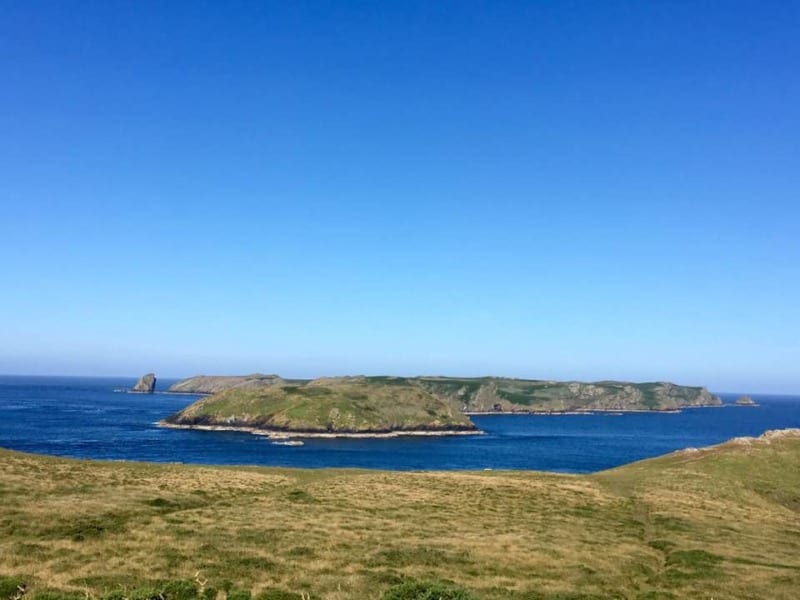
Skomer Island as seen from the mainland. As you can see, it’s not a huge island, but there sure is a lot to explore! Photo by Christa Rolls
About Skomer Island
The Wildlife Trust of South and West Wales has managed this site since 1959 when the island officially became a National Nature Reserve. Although some of the species found on the island dwindle in other parts of the world, here, they thrive.
Implementation of maximum visitor capacity days (with no more than 300 visitors allowed in a day) and well-organized boat landings make maintaining the site easier. Biologists are able to get face-time with each visitor coming to the island. They provide an information brief to discuss the history of wildlife and conservation on the island, as well as conservation concerns.
Also, some of the most complete ruins from the Iron Age can be found on Skomer. They are found in the form of hut and cairn remains scattered around the island. The biggest mystery found on Skomer, however, is the Harold Stone, a large standing stone presumed to have been used as a marker for incoming boats.
Watch Your Step!
The Island has designated dirt and boardwalk pathways crisscrossing the edges and center of the island. These are designed to ensure visitors walk only on the pathways.
One step, tripod leg, or backpack placed outside of the pathway could mean collapsing an unseen burrow, in which there could be live animals.
Remember to reduce your impact as much as possible. Kindly remind others if you see behavior that can be dangerous to birds or their young.
Having the opportunity to go birdwatching on Skomer Island is a special one – we should preserve that as much as possible!
What to see and do on Skomer Island
Skomer is a birdwatching paradise, especially for those interested in seeing large colonies of birds incredibly close.
It’s also a prime location for seeing seals throughout the year. The best time to see seals, though, is around September when seals arrive to the Island to mate. Skomer Island’s location on the coast makes it incredible for dolphin and porpoise spotting, including Harbor Porpoises.
Most people will only visit the island for the day, as island accommodations are limited.
Once you are dropped at the boat dock, you’ll receive a briefing from the biologist on staff. This briefing covers the dos and don’ts of being in such close proximity to wildlife!
You are then free to wander around the island’s trails and take in everything Skomer has to offer. There is a picnic area near the old farmhouse in the center of the island, as well as restrooms, but otherwise, the Skomer is totally free of other usable structures.
There are a whole host of birds to see on Skomer – below are the most common.
Grab our Skomer Island Species Checklist to bring along with you on your trip!
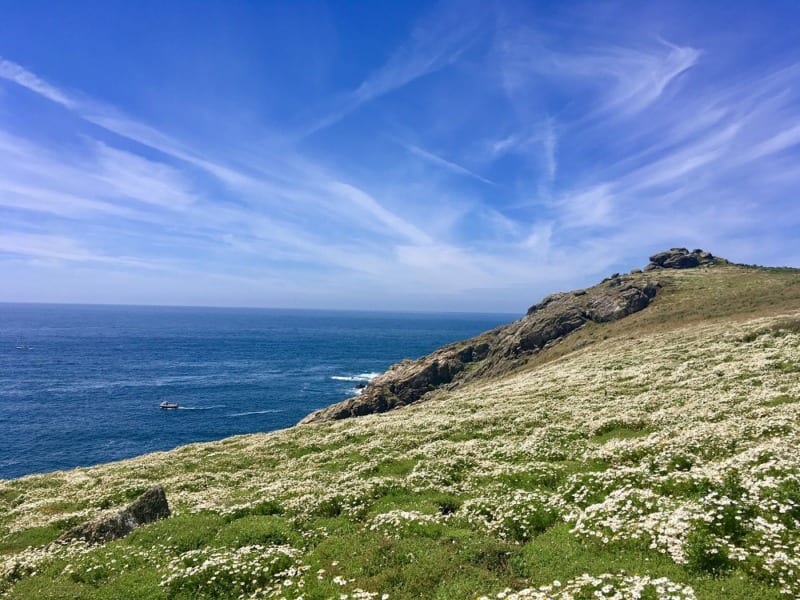
Starting in May through July, various wildflowers cover the rocky ground found throughout Skomer Island. Blue sky days in Wales are rare, but they do happen! Photo by Christa Rolls
Atlantic Puffin
Often referred to as the clowns of the bird world, Puffins are loved by many, and it’s easy to see why. They’re charismatic and loyal (they typically keep the same mate year after year). And, watching them bobble on two orange, flippered feet reminds one just how vulnerable they are on land.
In the water, on the other hand, they are masters of their domain. They zip with great speed through chilly waters in search of sand eels, tiny fish the size of a sardines, to bring back to their young. Amazingly, they can fill their large bills with dozens of small fish, an impressive sight for such a small animal!
Biologists on the island remind visitors that although these wonderful creatures are great at photo ops, they have an alternative purpose for standing right in front of you and your camera. They are trying to reach their burrow to get to their young.
Backing up even a few feet can remedy this. The puffin will go bounding right across the path and into their burrow before you can blink twice.
Nathan captured the featured puffin photos by sitting low on the designated path away from other visitors and waiting. Patience pays off well for those who exercise it!
Here are our top wildlife photography tips to bring with you on your trip!
Birdwatching on Skomer Island is made even more fun by getting to see these birds so close!
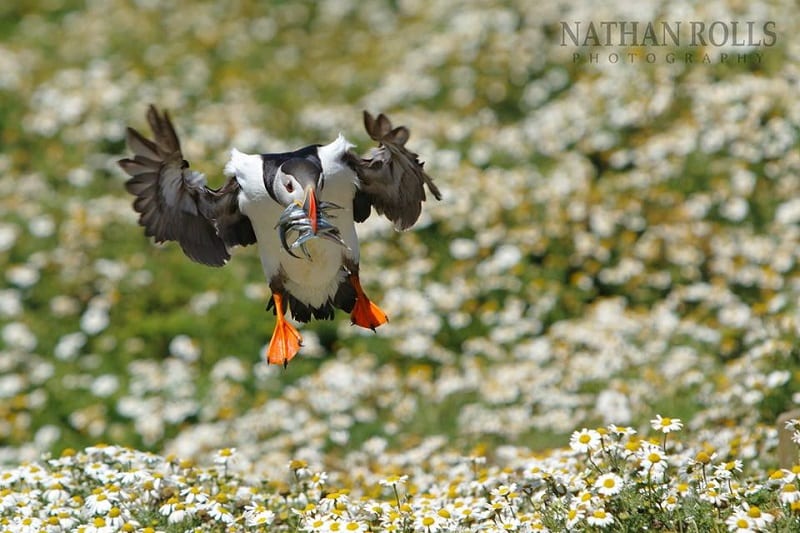
An Atlantic Puffin lands in a bed of wildflowers, where its burrow is obscured from view. It takes a mouthful of sand eels to its young, hidden underground. Photo by Nathan Rolls
Manx Shearwater
The largest breeding colony of Manx Shearwaters lives and breeds on Skomer Island. At nighttime, the air comes alive with them and their calls. There are estimated to be over 300,000 breeding pairs of Manx Shearwaters on Skomer alone. You can imagine the sight of seeing tens of thousands of Shearwaters all at one time!
Living in the burrows seen throughout the island, Shearwaters build their nests underground in burrows. This is where their young hideaway during the day.
The adults spend the day feeding at sea, and return under the cover of night to feed their young. The speed at which they flit in and out of their holes is incredible.
You’ll likely spot numerous deceased Shearwaters as you walk the trails.
They are predated upon heavily by Greater Black-backed Gulls. Lying in wait, the Gulls catch the comparably smaller birds if they have not reached the safety of the sea or their burrow before dawn.
Guillemots
There are around 20,000 Guillemots found on Skomer, especially along the rocky and steep cliffs leading down to the seas.
Look out for how close together they nest to each other!
You’ll begin seeing these beautiful birds as you boat over to the landing dock on the Island. Otherwise, the best place to spot them is on the west side of the Island, near the Puffin colony.
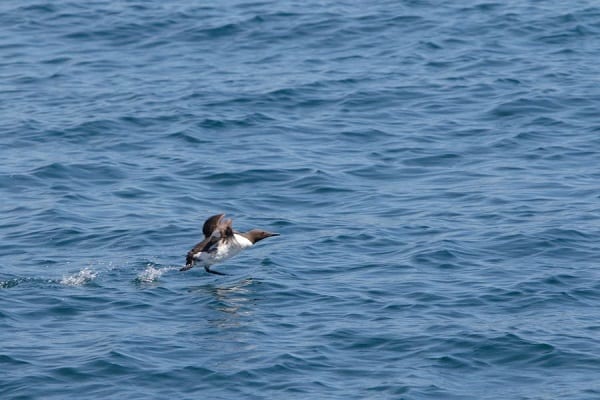
Many sea birds need to get a running start on water before they can take off. They need to get lift (or thrust) under their wings to get into the air for flight! Photo by Nathan Rolls
Best time to visit and go birdwatching on Skomer Island
Skomer is only accessible from 1 APRIL to 30 SEPTEMBER. It is closed on Mondays to serve as a “recovery day” for the island and its staff.
Spring and summer yield a variety of birdlife, with breeding season really picking up in late spring and early summer.
By the end of August and into September, Atlantic Grey Seals come to the shores of Skomer to mate. By then, you can see them and their pups from a distance.
Keep in mind that many of the birds will be back at sea by late summer, so if they are your objective, don’t wait until August to visit. No matter when you come, though, the Island has a wealth of wildlife and beauty to offer you!
We LOVE birdwatching on Skomer Island. Be sure to check out other places to birdwatch in Europe!
Getting to Skomer and Accessibility on the Island
Interested in visiting Skomer Island? Getting there and obtaining your tickets takes a little planning ahead.
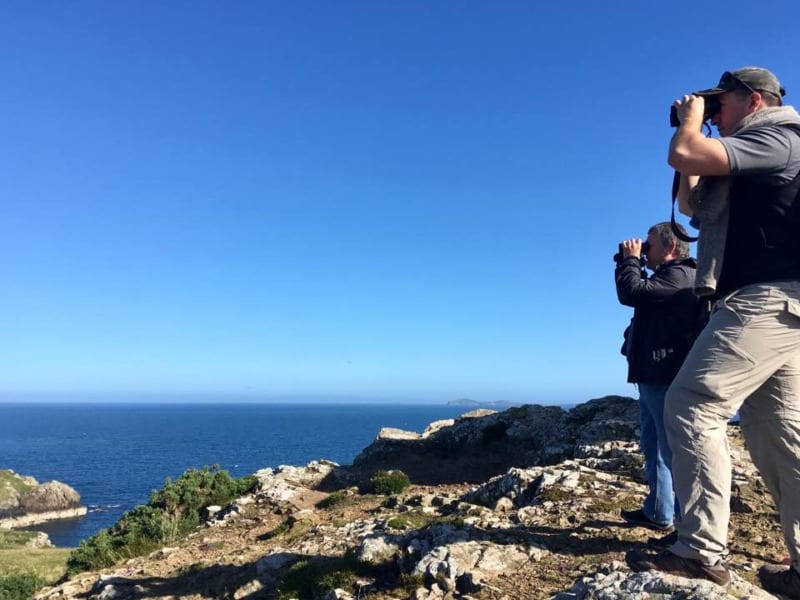
Take some time after you get your ferry ticket to explore the coastal area near the docks. The views are spectacular! If time permits, stay and watch the sunset from this beautiful perch above the sea. Photo by Christa Rolls
Logistics of getting to Skomer Island
The Lockley Lodge Visitor’s Center is the gateway to Skomer Island. It is from here that you purchase your boat landing ticket and pay the access fee for entry onto the island.
The easiest way to reach the Lockley Lodge Visitor’s Center is by car. If you can get a smaller vehicle, even better. The roads can be quite narrow – there are small pull-offs to allow other cars to pass or vice versa.
Alternatively, Milford Haven is the next closest town to the Visitor’s Center, which can be reached by bus or train. From there, however, you’ll need to hitch a ride or get a taxi to Lockley Lodge.
You’ll pay around £5 for parking next to the Visitor’s Center, and walk about 100 feet to reach the Visitor’s Center entrance.
Getting on Skomer Island
Be sure to arrive around an hour before the Visitor’s Center opens at 8 AM. Most especially keep this in mind on days predicting nice weather. Skomer allows a limited capacity of visitors per day to the island, and only three ferries run any given day. Tickets will sell out quickly, and you’ll be surprised at how early people arrive to ensure they get a ticket!
The ferries leave at 10 AM, 11 AM, and noon. Return trips back to the mainland start at 3 PM for the first group of visitors, 4 PM, for the second, and 5 PM for the last group.
Visitor’s arriving on the 10 AM ferry are required to go back to the mainland on the 3 PM ferry unless there are people from later ferries who wish to leave earlier, in which case you are able to switch boats with them. This ensures that everyone is able to fit on the boat in the three trips back to the mainland.
Ticket Requirements
You’ll pay two separate fees for visiting Skomer.
The first is a landing fee to access the island (£11 for adults, £5 for 1-15-year-olds, FREE for members; payable by credit card at the Visitor’s Center).
The second is the boat fare to ferry you from the mainland to the island, which is paid directly to the boat captain in cash (£11 for adults, £7 for 1-15-year-olds). Children under 1 year old can visit the Island for free.
If you’re interested in becoming a member, you can call, sign up online, or sign up on-site. It’s worth it if you plan to visit Skomer at least twice a year, as the landing fee is waived and you get priority on island accommodation.
This is a great way to get perks while donating to the Wildlife Trust of South and West Wales. And, the money goes directly back into managing their properties and acquiring other properties for conservation.
Accessibility
After a 15 minute ferry ride to Skomer, you will have a series of steep steps, 87 to be exact, that you must climb to reach the main pathway.
There are limited facilities for restrooms on the island, and there is currently no café available. However, water can be purchased on the island and snacks in the Visitor’s Center before boarding the boat.
We recommend bringing a backpack with water and snacks to tide you over for your entire day trip.
If the weather forecast looks grim, give the Visitor’s Center a call to make sure the boats will be running for the day (+44 (0)1646 636800). This can happen, and it’s for your safety that they choose not to run the boat. The Wildlife Trust of South and West Wales will post on their Facebook page and their Twitter Page with any boat updates.
Even if bad weather comes in, check out the nearby villages and Pembrokeshire coastline. The mist and clouds only add to the mystery and wildness of this incredible landscape. Keep reading for recommendations of things to do in the area!
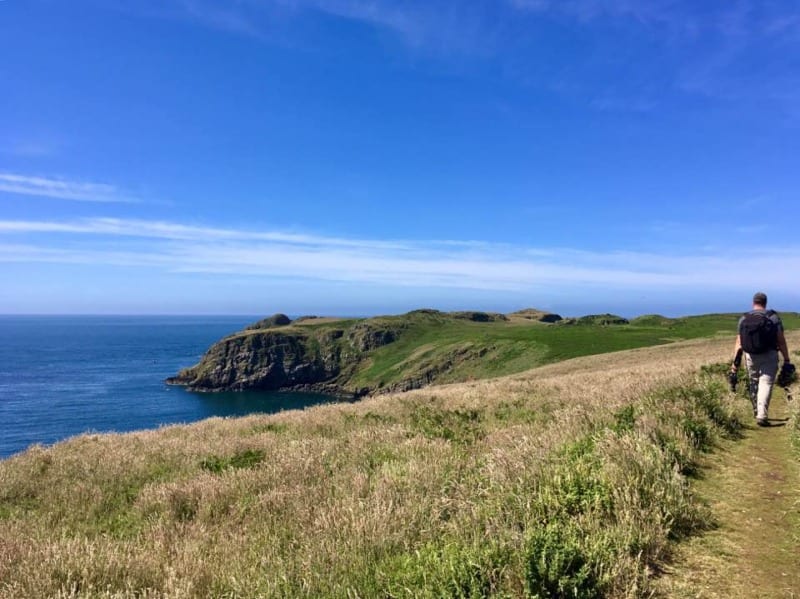
The pathways near the water and burrows make birdwatching on Skomer Island easy. Keep in mind the paths are grassy, rocky, and sometimes narrow. Photo by Christa Rolls
Lodging on or near Skomer Island
If you’re lucky, you can stay on the Island itself in its hostel accommodations. You must, however, book well ahead of time or be a member of the Welsh Wildlife Trust.
The reason I say “lucky” is because these spots fill up quickly and members of the Welsh Wildlife Trust get priority on accommodations. Reservations for the upcoming season always begin in October.
The accommodation has everything you would need for a no-frills stay on a wild island, including a bed and a shared kitchen in which to make your food. Note that the bedrooms do not have outlets to charge your phone or camera.
There is a minimum of a two-night stay during the height of summer since this is such a popular time of year for people to visit the Island. Give yourself a buffer of a day or two after you plan to arrive back to the mainland. This spares you in the event that inclement weather prevents the boat from coming to pick you up.
There are many places to stay on the mainland even if you aren’t able to secure a spot on Skomer. We stayed in nearby Saint Ishmaels, a quaint and quiet town just a 20-minute drive away from the docking point. Milford Haven is another town closeby, with B&Bs, hotels, and AirBnB options. Some great options are Fields Lodge Bed and Breakfast and North Headbourough Bed and Breakfast.
Use the map below to look up other available accommodations near Skomer:
Gear considerations for birdwatching on Skomer Island
If you’re going to be birdwatching on Skomer Island, we suggest packing the right gear.
Weather can be very unpredictable on the coast, so bring a rain jacket and rain pants (if available). Don’t forget suitable footwear to traverse the steps and pathways. And no birdwatching trip is complete without your camera and binoculars!
You can rent binoculars at the Visitor’s Center for a small fee and buy a disposable camera (yep, you’ll need to get that film developed!). If you don’t bring or rent these items, you’ll still see a ton of wildlife. In particular, the sea birds are within easy view of the walking paths and small mammals scurry around the brush.
Volunteers are stationed at various locations on the island with scopes to show you some of the coolest sites. And of course, the puffins will land just next to you to get to their burrows.
We had perfect weather on our trip to Skomer, but that’s not always the case. Here are some gear pieces we brought in anticipation of bad weather and were essential to our trip birdwatching on Skomer Island:
Other things to do in the area
In the event of bad weather, the ferries will not run to the island. The ferries do not run on Mondays, so consider this if your visit falls on this day of the week.
Try out a one-day tour of northern Wales, or go on a full-blown 5-day Welsh adventure!!
Visit one of the many National Parks
The Pembrokeshire Coast National Park is one of the most beautiful hiking and driving destination in all of the United Kingdom.
If time permits, head further up the coast to hike one of the many trails, see one of the hundreds of waterfalls, or explore a small Welsh village in Snowdonia National Park.
The region is beautiful – we highly recommend the hike up to Mount Snowdon via the Llyn Cwellyn parking area.
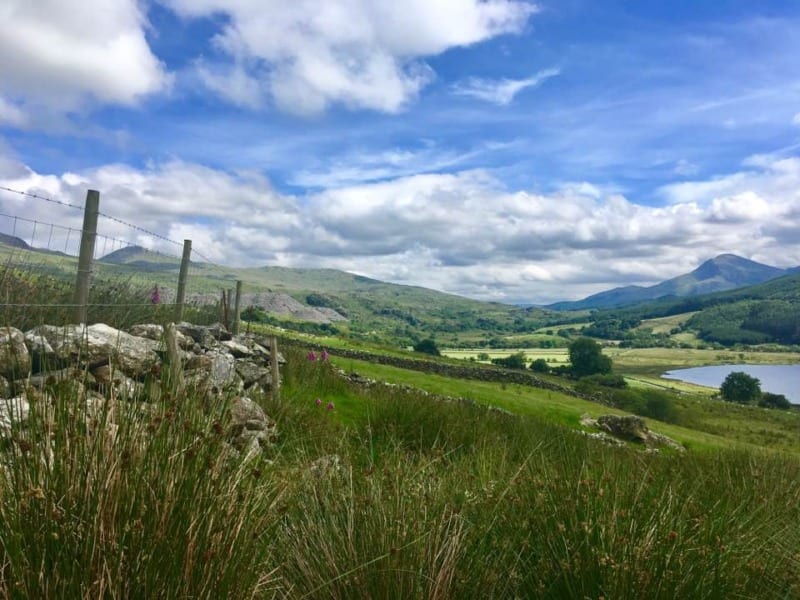
Views from the trail leading to Mount Snowdon from the Llyn Cwellyn parking area. Photo by Christa Rolls
Step back in History
Tour the Pembroke Castle and grounds, including the Castle’s great keep. You’ll have great views and a cafe to warm your soul on a typically cool and foggy Welsh day. Seeing the Castle in this kind of weather really adds to the drama and mystery of the region!
Do some more birdwatching!
About an hour’s drive away is the Gigrin Family Farm, which has the largest congregation of Red Kites in the area. They have hides for birdwatchers and photographers to experience hundreds of Red Kites. The kites are fed in a designated spot to draw crowds to a controlled location. This ensures the nesting and habitat safety of the animals by controlling where people visit.
Skomer Island holds a special place in our hearts. Their conservation initiatives and hard work preserving the landscape and the animals that live there is so special.
What’s more, the scenery is absolutely magical. There are few places you can go where sea birds are so close that you have to move out of their way regularly.
Visit and go birdwatching on Skomer Island for an unforgettable wildlife experience!
Happy birding and travels!
Christa and Nathan
Have you been to or plan birdwatching on Skomer Island? Have questions about your upcoming visit? Let us know in the comments!
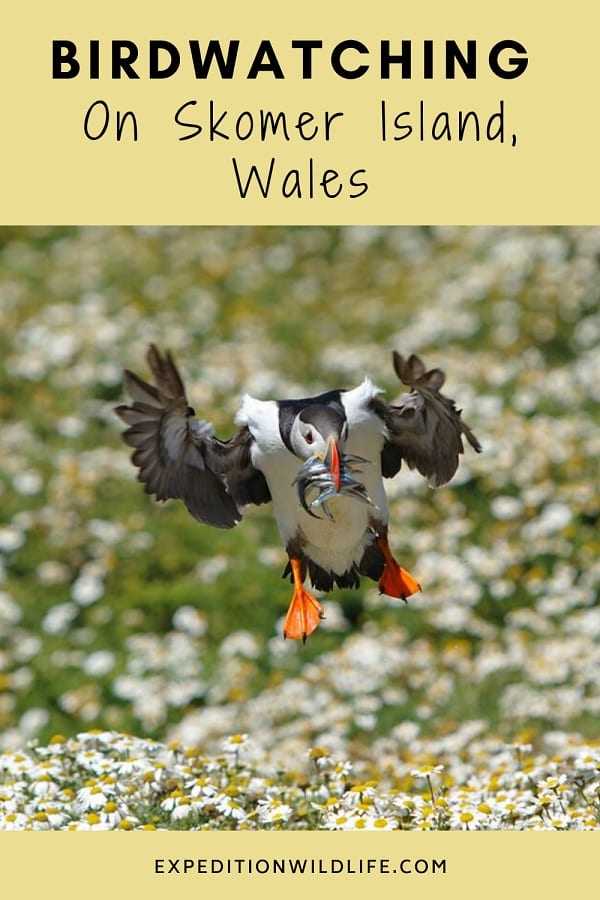

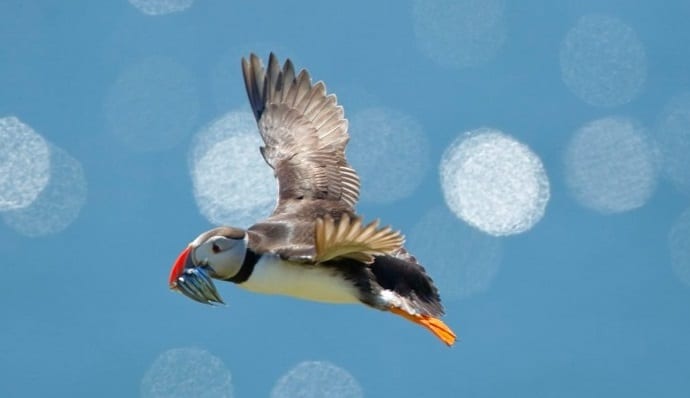


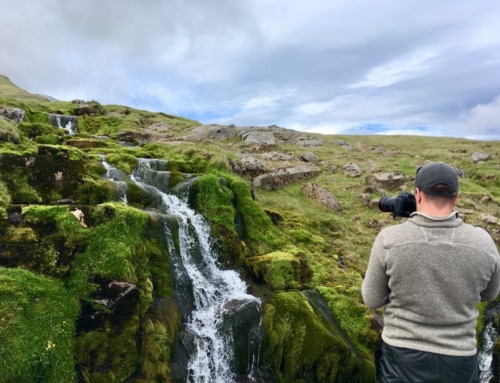
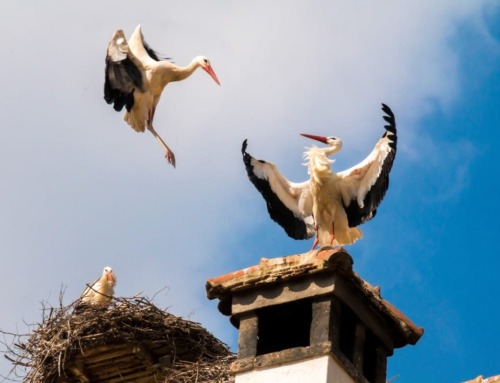


Leave A Comment